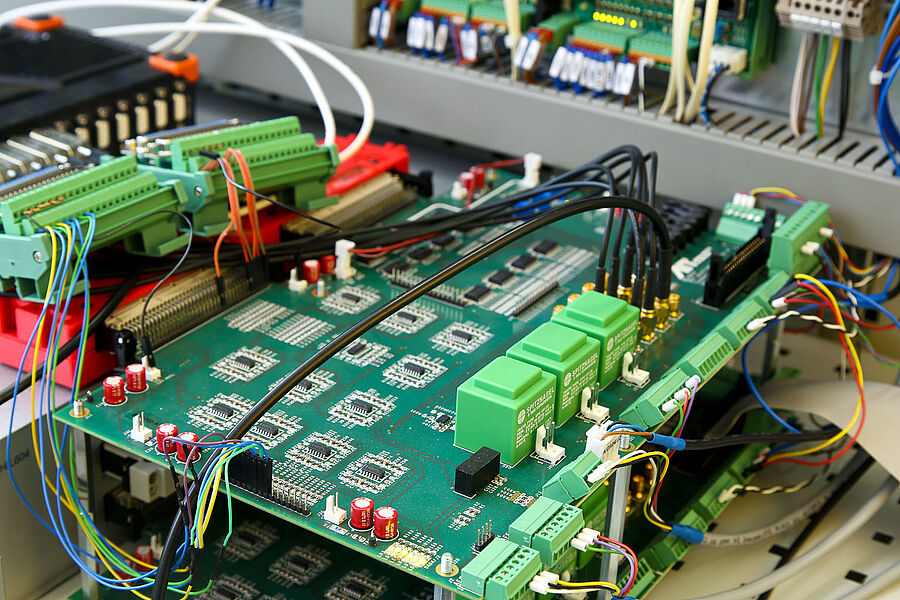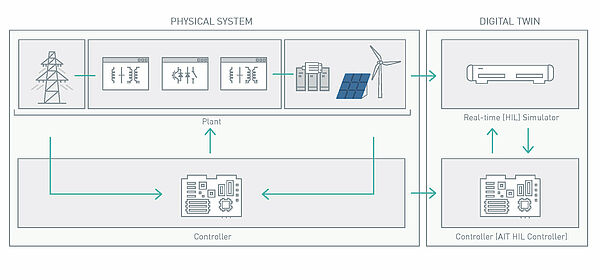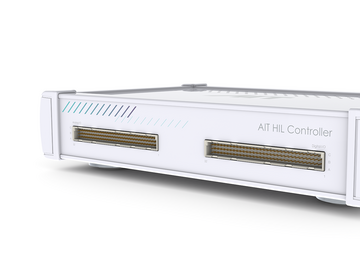Controller Hardware-in-the-Loop: Innovation for the Development of Modern Power Electronics
Controller Hardware-in-the-Loop (C-HIL) methods are becoming increasingly important in the development of new power electronic systems, particularly in the context of energy conversion and renewable energy. For components of energy supply systems, where high power and energy levels are involved, it is crucial to rigorously test new solutions before they are deployed in power grids, onboard networks, or power plants.
What is Controller Hardware-in-the-Loop?
Controller Hardware-in-the-Loop (CHIL) connects the power electronics part of a system, represented as a real-time model, with the physical control hardware via a custom interface. This method allows testing of control systems under real and extreme conditions—without incurring hardware risks. Applications for CHIL range from AC-to-AC, AC-to-DC, DC-to-AC, and DC-to-DC converters and can be scaled to any power class.
By utilizing CHIL, developers can design more efficient, robust, and grid-compliant systems that meet the challenges of modern energy systems.
Controller Hardware-in-the-Loop offers:
- Risk-free testing under real and extreme conditions.
- Accelerated development cycles.
- Efficient troubleshooting and optimization.
How Does Controller Hardware-in-the-Loop Simulation Work?
In a Controller Hardware-in-the-Loop (C-HIL) simulation, physical system components such as sensors, actuators, and converters are virtually replicated in a real-time simulation environment, while the actual Device Under Test (DUT) is physically integrated into the process. A typical test setup is divided into two main layers: a virtual layer, where part of the system is modeled and simulated in real time, and a physical layer, consisting of the DUT. In a C-HIL test setup, the DUT is the actual controller, including its hardware, firmware, and software. The interaction of the controller with the simulated environment mirrors the physical system and includes the reproduction of various test conditions and scenarios. Through continuous signal and data exchange between the controller and the simulator, real-time feedback is ensured, allowing the controller to respond exactly as it would in a real system. This enables an almost identical replication of real-world conditions, providing a safe and thorough performance validation before integration into an actual system.
Application Areas of Controller Hardware-in-the-Loop (CHIL)
Power Electronics:
Controller Hardware-in-the-Loop testing is crucial to ensure the reliability, safety, and efficiency of power converters in various applications. These include drive systems, power factor correction filters, decentralized energy resources (DERs) such as solar inverters, wind turbines, and energy storage systems.
E-Mobility:
CHIL testing is essential to guarantee seamless integration, reliability, and optimal performance of electric and hybrid vehicles, trains, trucks, electric motorcycles, and bicycles. This includes testing of the electric drive system, battery management systems, onboard and offboard chargers, and communication between vehicles and charging stations.
Grid Modernization:
With the progress of the energy transition and the increasing share of inverter-based sources, new challenges arise. The CHIL methodology enables comprehensive testing and validation of complex systems prior to implementation. This approach minimizes the risk of failures through system-wide testing and interoperability assessments.
Advantages of Controller Hardware-in-the-Loop (C-HIL)
- Reduced Development Time
Parallel simulation and validation accelerate the journey from design to market readiness. - Enhanced Testing Accuracy
C-HIL enables precise simulations of grid conditions, load changes, and extreme scenarios. - Safe Testing
Critical test scenarios can be conducted without risking damage to physical components. - Cost Efficiency
Fewer hardware prototypes lead to lower development costs.
INTERFACE DEVELOPMENT & PROTOTYPING
INTERFACE DESIGN AND MODEL DEVELOPMENT
Our experts provide comprehensive support in designing custom real-time system interfaces and developing specific C-HIL (Controller Hardware-in-the-Loop) models. We craft tailored interfaces between the real-time system emulator and the target controller hardware and have extensive practical experience with leading real-time system providers such as Opal RT, PLECS RT Box, and Typhoon HIL. Additionally, we develop specialized C-HIL target application models for various use cases, including PV inverters, energy storage systems, microgrids with active harmonic filters, as well as MVAC, MVDC, HVDC, smart grids, and other energy system applications.
SUPPORT FOR CONTROLLER DESIGN AND DEVELOPMENT
With extensive expertise in power electronics design and testing, AIT offers a range of services:
We provide an AIT real-time system environment, develop controllers through offline and real-time simulations, and perform rapid prototyping of controller systems. This can be executed either within the AIT controller or on the user’s target control platform.
DESIGN PRE-QUALIFICATION TESTS AND VALIDATION WITH HIL TECHNOLOGY
AIT delivers advanced services for design validation, including:
- Design Validation in the Laboratory
- Enhanced C-HIL Testing: Comprehensive testing using various grid models under extreme conditions.
- Automated Testing Development: Creation of Python script-based, fully automated, and application-specific testing procedures.





